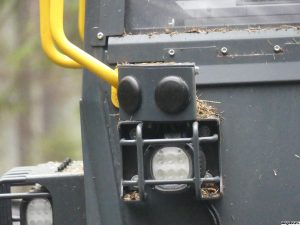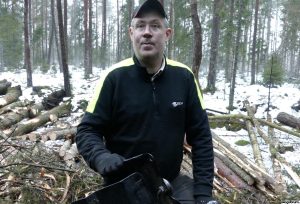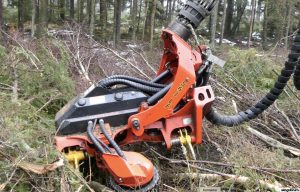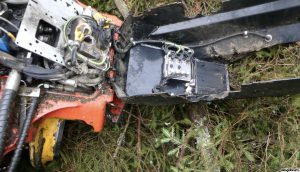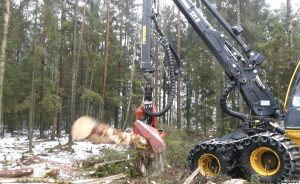In November last year, the technology company Dasa in south Sweden launched the World’s first wireless control system for harvester heads – Dasa Wireless 1. Except for power supply, all cables between the cabin and head now can be removed. The result is a harvester with fewer parts that can break down and to maintain.
Dasa Wireless 1
The harvester head manufacturer SP Maskiner has tested the system on a harvester for one year now. The sister-site Skogsforum.se visited a machine that is equipped with one of the first Wireless 1 systems to find out more.
The contractor Ola Bokelund has been testing pilot for the system and Skogsforum.se visited him already one year ago to see his new Eco Log 1058H harvester (former Gremo). The Dasa Wireless 1 was already running on the machine back then, but that was a secret.
Antennas on head and cabin
The only visible detail that reveals the wireless system are the antennas on the cabin and the harvester head. They look a bit like ice hockey pucks, four of them are placed on the head and four on the cabin. Under the hood of the harvester head, a control unit that sends and receives signals from the cab via the antennas is placed. This control unit replaces the long cables from cab to head that otherwise are required for the communication between the units. Now there is only one cable, for the power supply, from the cabin to the head.
Fewer disturbances and problems
According to Dasa, the wireless system should decrease disturbances and maintenance as there are fewer parts that could be damaged or break down. The environment in which a harvester head is operating, such as large forces, constant motion, and all kinds of weather, is challenging for advanced technology. The branches and other tree parts are always close and risk to damaging the head. So, to have less parts that could be damaged could only make things better for the machine owner according to Dasa.
Another advantage is when revolving heads are used, which is common in north America and in plantation forestry. As for the hydraulic system there are priceworthy solutions available, but similar solutions for cables are both expensive and complicated. So, also here the machine owner gains from the Dasa Wireless 1 system.
One year’s experience of the testing
Skogsforum.se asked Ola Bokelund about his experience so far. He says that he notices no difference in speed or accuracy between the wireless and the traditional systems. All functions react just as quick, both for controlling the head and for the bucking computer.
Ola did have some worries about the antennas and their ability to function under snowy conditions. However, after two winters with several days in snow there has so far been no problems. Ola even packed snow on the antennas to see if there would be any difference, but there wasn´t.
Quick switch of harvester head in the computer
One advantage that Ola discovered is that the switch between different harvester heads is faster. He uses a small SP 461 LF in thinning, and the larger SP 561 LF in final felling, as when Skogsforum.se visited him. Both heads have their own antennas and control systems and the switch in the computer is done quick and smoothly.
Film and more information
Here you can read more about DASA Wireless 1.
And here is a film from the visit:
Film and photos: Torbjörn Johnsen






